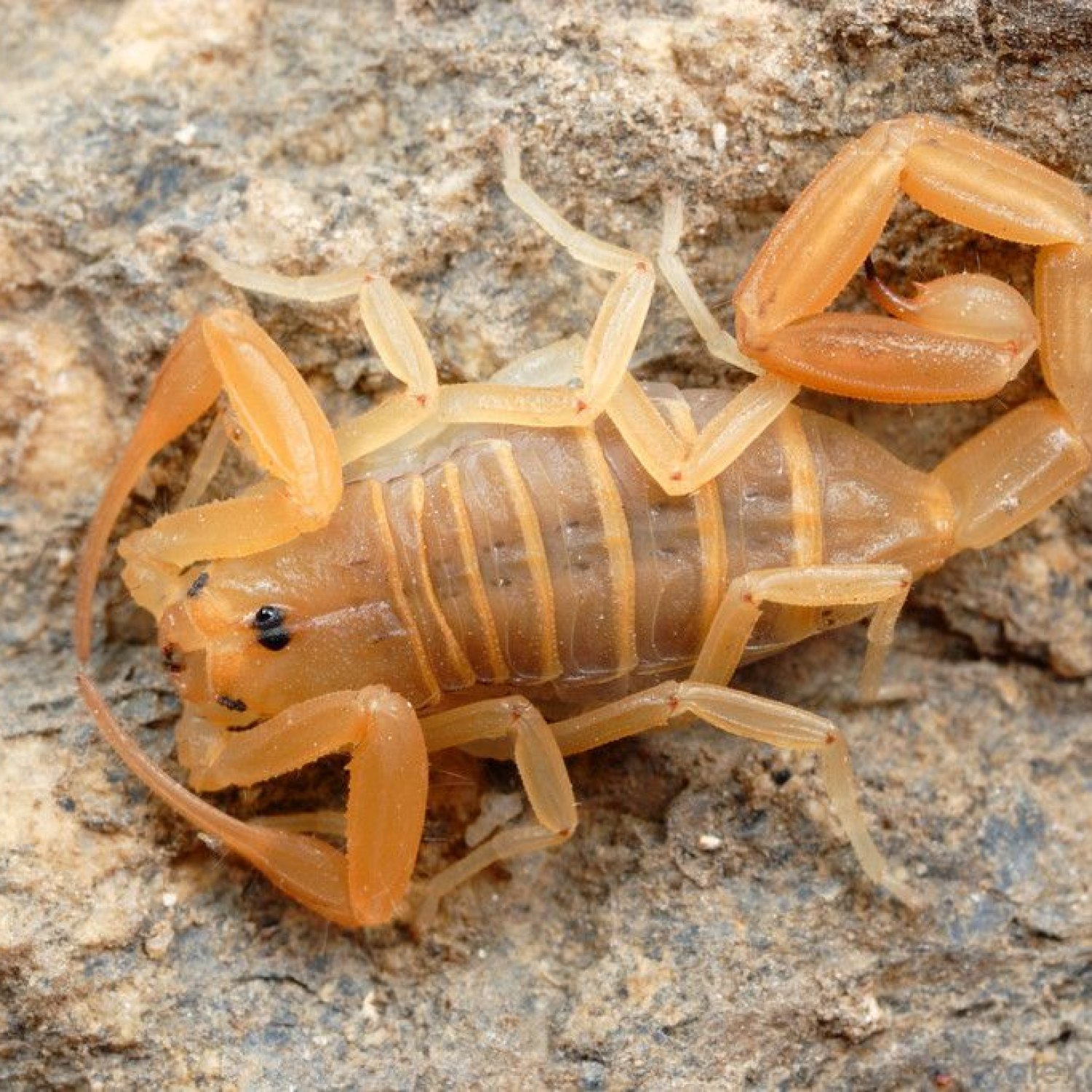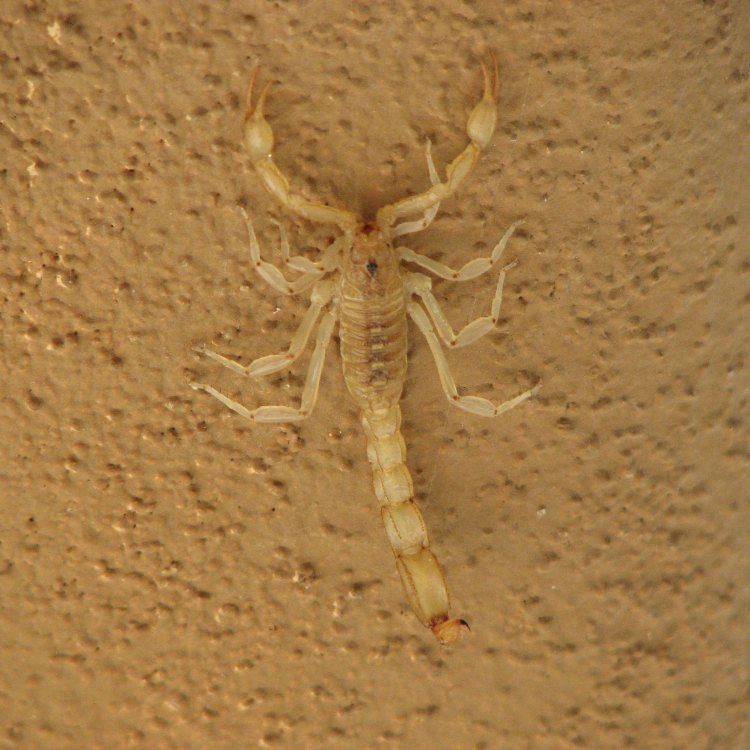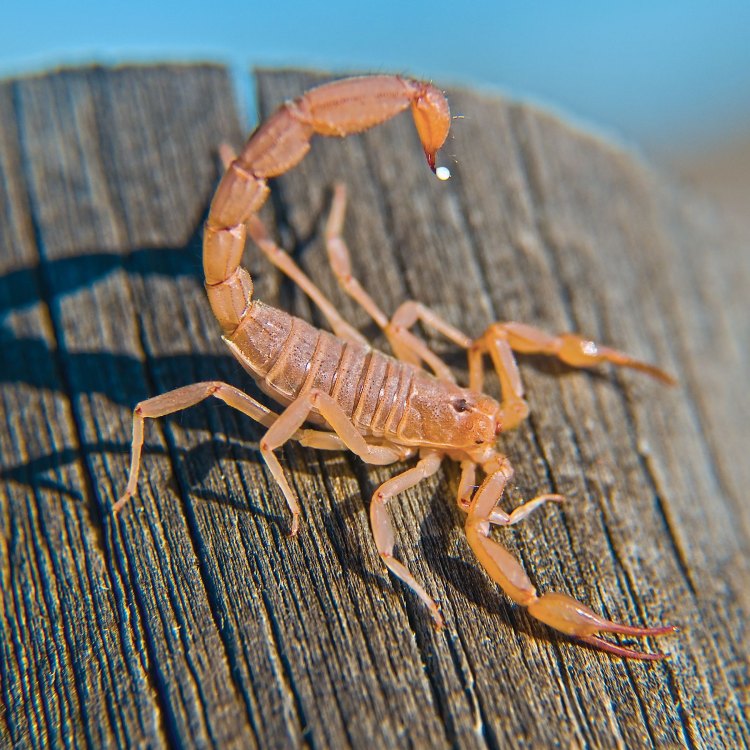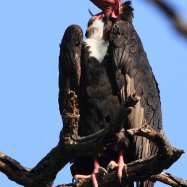
Arizona Bark Scorpion
2.75 to 3 inches
The Arizona Bark Scorpion, with its slender body and curved sting, is a dangerous arachnid found in the southwestern US. With a length of 2.75 to 3 inches, it is a small but deadly member of the Buthidae family. Make sure to steer clear of this venomous creature found in its namesake state.
Animal Details Summary:
Common Name: Arizona Bark Scorpion
Kingdom: Animalia
Habitat: Deserts, rocky areas, and woodlands
The Mighty Arizona Bark Scorpion: A Unique and Deadly Arachnid
Deep in the desert of Arizona, amongst the rocks and woodlands, dwells a creature unlike any other. Its appearance may strike fear into the hearts of many, but the Arizona Bark Scorpion is an intriguing and remarkable animal that is an essential part of the ecosystem.Scientifically known as Centruroides sculpturatus, the Arizona Bark Scorpion belongs to the kingdom Animalia, making it a member of the animal kingdom. It falls under the phylum Arthropoda, with its characteristic jointed legs and exoskeleton Arizona Bark Scorpion. As a member of the class Arachnida, this creature is related to spiders, ticks, and mites.
The Arizona Bark Scorpion belongs to the order Scorpiones and the family Buthidae. It is a close relative of other venomous scorpions, such as the Deathstalker and the Black Fat-tailed Scorpion. However, this species is unique to the southwestern United States and northern Mexico. Its presence in these regions is crucial to maintain the balance of the ecosystem.
This scorpion is known by its common name, the Arizona Bark Scorpion, due to its habitat preference. It can usually be found in deserts, rocky areas, and woodlands, where it blends into its surroundings with its yellowish-brown to brown coloration. However, its small size allows it to easily crawl into homes and buildings, leading to accidental human encounters.
Being carnivorous, the Arizona Bark Scorpion mainly feeds on insects, spiders, and other small arthropods African Fish Eagle. It is also known to prey on other scorpions, making it a top predator in its habitat. Its feeding method is quite interesting, as it uses its front claws to capture its prey and then uses its powerful sting to paralyze it.
The geographical distribution of the Arizona Bark Scorpion includes the states of Arizona, California, Nevada, New Mexico, and Utah in the southwestern United States, as well as northern Mexico. Its range covers a significant portion of the Sonoran Desert, making it an important species in this desert ecosystem.
The origins of the Arizona Bark Scorpion can be traced back to the United States, specifically the state of Arizona. It was first described in 1801 by French naturalist André Marie Constant Duméril and is still commonly found in this state. Its presence in the arid climate of Arizona makes it a resilient creature, able to withstand extreme temperatures and harsh conditions.
One of the most striking features of the Arizona Bark Scorpion is its body shape. It has a slender body with a long tail and a curved sting at the end. This shape allows it to easily maneuver in tight spaces and defend itself against predators. Its sting is located at the tip of its tail, and it is capable of injecting its potent venom into its prey or an attacker.
This scorpion's size varies between 2.75 to 3 inches in length, making it one of the smaller species of scorpions. However, do not be fooled by its size, as it packs a powerful sting. Its venom contains neurotoxins that can be lethal to its prey and potentially deadly to humans. However, despite its venomous capabilities, the Arizona Bark Scorpion is generally non-aggressive and will only sting in self-defense.
The Arizona Bark Scorpion has unique adaptations that allow it to survive in its harsh desert habitat. Its exoskeleton helps to minimize water loss, and its ability to dig and burrow allows it to seek shelter from the scorching sun. It is also a nocturnal creature, only emerging at night to hunt for food.
One of the most interesting aspects of this arachnid is its mating behavior. Male scorpions use a unique mating dance to attract females. This dance involves tapping its pincers on the ground, vibrating its body, and waving its tail in the air. Once a female is interested, the male will grasp her claws with his own and lead her to a suitable location for mating.
After mating, the female will give birth to live young, ranging from 25-35 in a single litter. These young scorpions will stay with their mother for a short period before venturing off on their own. The Arizona Bark Scorpion has an average lifespan of 3-5 years in the wild.
Despite its venomous reputation, the Arizona Bark Scorpion plays a crucial role in its ecosystem. As predators, they control insect populations, helping to maintain balance within their habitat. They are also a food source for larger animals, such as birds and reptiles, further contributing to the food chain.
However, human encounters with the Arizona Bark Scorpion can be dangerous and should be avoided. Their venom can cause severe pain, paralysis, and sometimes even death. In case of a sting, immediate medical attention should be sought.
The Arizona Bark Scorpion has also captured the attention of scientists and researchers for its unique venom. Research is being conducted to understand its potential use in treating diseases and developing new medications. Its venom contains a peptide that can potentially be used as a painkiller, and research is ongoing to harness this capability.
In conclusion, the Arizona Bark Scorpion may not be the friendliest or most well-known creature, but it is undoubtedly a remarkable and essential part of the desert ecosystem. Its unique features and behaviors make it a fascinating subject for study, and its presence in the southwestern United States is crucial for maintaining the balance of nature. So, the next time you see a scorpion scurrying around, remember to admire its unique characteristics from a safe distance.

Arizona Bark Scorpion
Animal Details Arizona Bark Scorpion - Scientific Name: Centruroides sculpturatus
- Category: Animals A
- Scientific Name: Centruroides sculpturatus
- Common Name: Arizona Bark Scorpion
- Kingdom: Animalia
- Phylum: Arthropoda
- Class: Arachnida
- Order: Scorpiones
- Family: Buthidae
- Habitat: Deserts, rocky areas, and woodlands
- Feeding Method: Carnivorous
- Geographical Distribution: Southwestern United States and northern Mexico
- Country of Origin: United States
- Location: Arizona
- Animal Coloration: Yellowish-brown to brown
- Body Shape: Slender with long tail and curved sting
- Length: 2.75 to 3 inches

Arizona Bark Scorpion
- Adult Size: 2.75 to 3 inches
- Average Lifespan: 3 to 5 years
- Reproduction: Sexual
- Reproductive Behavior: Males perform courtship rituals
- Sound or Call: Does not produce sound
- Migration Pattern: Non-migratory
- Social Groups: Solitary
- Behavior: Nocturnal
- Threats: Habitat loss, pesticide use, and extermination efforts
- Conservation Status: Not evaluated
- Impact on Ecosystem: Important predator of insects and other arthropods
- Human Use: None
- Distinctive Features: Glow under UV light
- Interesting Facts: Can survive without food for several months
- Predator: Large spiders, birds, reptiles

Centruroides sculpturatus
The Fascinating World of Arizona Bark Scorpions
When you think of scorpions, you may envision desert landscapes and their distinctive appearance with a venomous stinger on their tails. These creatures have been a symbol of fear and danger, and rightly so, as their sting can be harmful to humans. However, not all scorpions are created equal, and the Arizona bark scorpion takes the lead when it comes to unique and interesting features.The Arizona bark scorpion, scientifically known as Centruroides sculpturatus, is a species of scorpion native to the southwestern United States and northern Mexico PeaceOfAnimals.Com. Let's take a closer look at this remarkable arachnid and explore its distinctive characteristics and behaviors.
Size and Lifespan
The Arizona bark scorpion is a relatively small species, with adults ranging from 2.75 to 3 inches in length. They are typically light brown, with a long, thin body and two grasping pincers. They also have six small eyes, which help them detect movement and prey.
In comparison to other scorpion species, the Arizona bark scorpion has a lengthy lifespan of three to five years. This may not seem like much, but considering their small size and the harsh desert environment they live in, it's quite long for an arachnid.
Reproduction and Courtship Behavior
Like most scorpions, the Arizona bark scorpion reproduces sexually, requiring a male and female to produce offspring. Males perform elaborate courtship rituals to impress females and win their mating opportunities Arapaima.
During mating, the male uses his pincers to grab onto the female's pincers and spin her around, often for hours at a time. If the female is ready to mate, she will then arch her body and allow the male to deposit his sperm via a special structure called a spermatophore. After mating, the male scurries off as the female carries the fertilized eggs in her body for several months.
Glowing Under UV Light
One of the most unique and fascinating features of the Arizona bark scorpion is its ability to glow under UV light. When exposed to ultraviolet light, the scorpion's exoskeleton emits a fluorescence that gives off an eerie blue-green glow. This phenomenon occurs due to a substance called hyaluronan in their exoskeleton, which reacts to UV light.
While this glow may seem like a cool party trick, it actually serves a purpose in the scorpion's survival. The fluorescence helps them blend into their surroundings, making it harder for predators to spot them in the dark. Scientists also believe that the fluorescence may play a role in their courtship rituals as males and females can easily identify each other in the dark with this glowing feature.
Behavior and Habits
The Arizona bark scorpion is a nocturnal creature, meaning they are active at night and seek shelter during the day. They are known for their burrowing behavior and are commonly found under rocks, logs, and in cracks and crevices. They can also be found in human-made structures such as homes and buildings, seeking out warm and dark areas to hide.
These scorpions are also solitary creatures, preferring to live alone and only coming together during mating and to compete for food and territory. They are territorial and will often fight off other scorpions and predators to protect their space.
Unique Survival Adaptations
As desert-dwellers, Arizona bark scorpions have several adaptations that help them survive in their harsh environment. They can slow down their metabolism and go without food for several months. This enables them to survive during the dry and cold months when food sources are scarce.
They also have unique respiratory and excretory systems, allowing them to conserve water and eliminate unnecessary wastes. These adaptations help them thrive in the desert where water is scarce and survival is challenging.
Threats and Conservation
Unfortunately, like many other species, the Arizona bark scorpion faces various threats that have impacted their population. Habitat loss due to urbanization and agriculture has reduced their natural habitat, leaving them with fewer places to call home. Pesticide use in these areas has also affected scorpions, as they are sensitive to these chemicals.
Moreover, extermination efforts by humans have contributed to the decline of Arizona bark scorpions. These creatures often get killed out of fear or perceived danger, while many others are captured and sold in the illegal pet trade market.
Despite these threats, the conservation status of Arizona bark scorpions has not been evaluated. However, it's crucial to understand their importance in the ecosystem and take measures to conserve their population.
Role in the Ecosystem
As predators, Arizona bark scorpions play a vital role in the ecosystem, keeping insect and other arthropod populations in check. They are particularly helpful in controlling the population of pests such as crickets, roaches, and grasshoppers, making them an essential part of the food chain.
In some parts of their range, the decline of Arizona bark scorpions has led to an increase in prey species, causing an imbalance in the ecosystem. This proves their significant role in maintaining a healthy ecosystem and highlights the importance of protecting these creatures.
Impact on Humans
While the Arizona bark scorpion may look threatening, they are relatively harmless to humans. Their sting can be painful and cause mild irritation, but it's rarely fatal to healthy adults. Children, elderly, and those with weakened immune systems are most at risk of serious reactions to their venom.
In fact, these creatures have been used in some cultures for medicinal purposes, with their venom believed to have healing properties. However, it's essential to avoid contact with these scorpions and seek medical attention if stung.
In terms of human use, the Arizona bark scorpion has no significant impact. Unlike other scorpion species, they are not used in traditional medicine or as a food source, making them relatively untouched by human activity.
Predators of the Arizona Bark Scorpion
As fearsome as Arizona bark scorpions may seem, they are not invincible. Several predators in their natural habitat prey on these creatures, including large spiders, birds, and reptiles. These predators have developed special adaptations to help them hunt and consume these scorpions without getting stung.
For example, birds have a thick, protective layer in their beak, making them immune to the scorpion's venom. Some spider species can withstand the sting by having thick, hairy exoskeletons, while others use their quick movements and agility to avoid the stinging tail.
In Conclusion
The Arizona bark scorpion may seem like a creature straight out of a horror movie, but they are much more than that. They have unique features and behaviors that make them one of the most interesting scorpion species in the world. However, their population decline due to human activities is cause for concern, and it's crucial to understand their significance in the ecosystem and take measures to protect them. So, the next time you come across an Arizona bark scorpion, admire its distinctive glow and appreciate its role in the delicate balance of nature.

The Mighty Arizona Bark Scorpion: A Unique and Deadly Arachnid
Disclaimer: The content provided is for informational purposes only. We cannot guarantee the accuracy of the information on this page 100%. All information provided here may change without prior notice.












